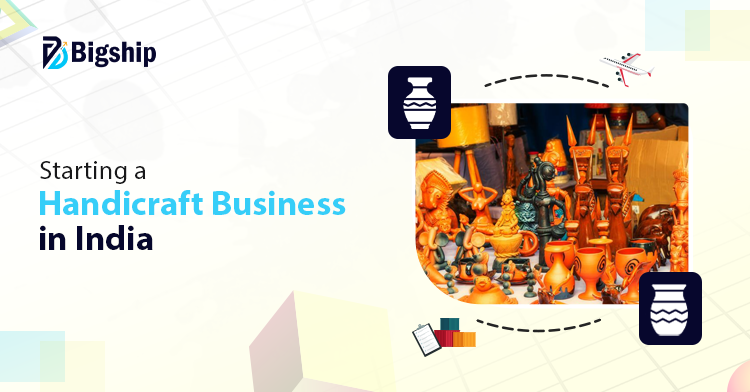Have you ever thought about turning your craft skills into a full-time business? If you love making handmade products and want to earn from them, then learning how to start a handicraft business can be your first step toward success.
The handicraft industry is growing, and people now prefer unique, handmade items over mass-produced goods. But making and selling crafts are two different things. To build a profitable handicraft business, you need the right plan, marketing, and pricing.
In this blog, we’ve covered all points on how you can start a handicraft business in India.
Best-Selling Handicraft Products in India
If you’re thinking about how to start a craft business, one of the first steps is understanding which products are in demand. India has a rich tradition of handicrafts, with skilled artisans creating everything from home decor to fashion accessories. Let’s have a look at some of the popular craft items in India.
Wooden Items: Wooden handicrafts have been a part of Indian culture for centuries. The demand for wooden items never fades be it furniture or decorative pieces. Indian states like Rajasthan and Gujarat are known for their detailed wood carvings, and many artisans from these states now mix traditional designs with modern styles.
Jute Craft: With more people shifting towards eco-friendly products, jute handicrafts have gained immense popularity. Jute is a durable, biodegradable material that artisans transform into bags, table mats, rugs, and wall hangings. Many buyers prefer jute items because they are stylish and sustainable at the same time. If you want to start a handicraft business in India, jute products could give you an edge in the market.
Bamboo Handicraft: Bamboo products are a great option if you’re interested in promoting sustainable products. Assam and Tripura are well-known for their bamboo handicrafts, including baskets, furniture, and home decor items. With more customers looking for eco-friendly alternatives, bamboo products have a strong market demand.
Pottery: Pottery is another handicraft that has remained relevant over the years. From clay vases and ceramic plates to decorative figurines, pottery has a wide customer base. Nowadays, there’s a growing trend of combining traditional hand-thrown designs with modern aesthetics. Eco-friendly and sustainable pottery options are also gaining attention. If you’re wondering how to start a craft business with a sustainable approach, pottery could be a great option.
Brass Products: Brass items have always been in demand, especially for home decor. Artisans from states like Andhra Pradesh craft intricate brass figurines, lamps, and candle holders. Today’s customers appreciate brass items that combine traditional and modern aesthetics. If you’re thinking of starting a craft business, brass decor pieces can attract buyers looking for unique and artistic designs.
Handloom Carpet: Indian carpets are famous for their fine craftsmanship, bold colors, and intricate designs. Woollen, silk, and cotton carpets each have their own customer base. Woollen carpets are popular for their durability, silk carpets are valued for their luxurious appeal, and cotton carpets are an affordable choice for everyday use. Selling carpets can be a profitable venture if you’re starting a handicraft business in India.
Handwoven Sarees and Silk Products: Silk weaving has deep roots in India, especially in West Bengal and Tamil Nadu. Handwoven silk sarees, shawls, and stoles continue to be in high demand, both in India and internationally. These products blend craftsmanship with tradition, making them a great option if you’re exploring how to start a craft business in textiles.
How to Start Your Handicraft Business in India?
Starting a handicraft business is an exciting journey, especially if you love creating unique products. But turning your passion into a profitable business requires more than just creativity. You need a solid plan, a clear understanding of your market, and the right strategy to reach customers. Here’s how to start a handicraft business the right way.
Understand Your Market and Customers
Before you start selling, it’s important to know who your customers are and what they want. Take time to research similar businesses and see what’s popular. Look at social media, join craft groups, and even talk to potential customers to understand their preferences.
For example, if you make handmade candles, you might find that customers prefer eco-friendly options with natural scents. Knowing this helps you create products that match their interests.
Key things to focus on:
- Who are your ideal customers? (Age, location, interests)
- What makes them buy handmade products? (For gifting, home decor, personal use)
- Where do they shop for crafts? (Online stores, local markets, social media)
Define What Makes Your Handicrafts Special
There are many craft businesses out there, so you need to stand out. Your unique selling proposition (USP) is what makes your products different from others.
To define your USP, think about:
- The materials you use (Are they eco-friendly or locally sourced?)
- The craftsmanship (Do you use a special technique?)
- The purpose of your product (Is it a personalized gift, home decor, or something else?)
For instance, instead of selling just handmade pottery, you could focus on hand-painted ceramic mugs inspired by Indian folk art. This makes your business more appealing to a specific audience.
Develop Your Product Line
Once you have a clear idea of your market and uniqueness, it’s time to design your products. Start with a few items that best represent your style and cater to your audience’s needs.
Here’s how to get started:
- Choose materials that align with your brand values.
- Experiment with different designs before finalizing your products.
- Get feedback from friends, family, or online communities.
- Ensure pricing covers your costs while staying affordable for customers.
Decide Where to Sell Your Handicrafts
There are multiple ways to sell your handmade products. You can start small and expand as your business grows. You can sell your products at local craft fairs or markets or partner with boutique stores or home decor shops. Apart from that you can create your own website or through different social media platforms to sell products online.
Build An Identity of Your Brand
Your brand is more than just a logo. It’s how customers see and remember you. A strong brand identity includes:
- A memorable business name.
- A well-designed logo.
- A consistent color scheme and packaging style.
- A unique brand message that tells your story.
For instance, if you specialize in eco-friendly crafts, your branding should highlight sustainability, from packaging to product descriptions.
Plan Your Marketing Strategy
Marketing is the key to getting your handicraft items get noticed. For that you don’t need a big budget, but the right approach. Some effective ways to promote your business include:
- Posting high-quality photos of your crafts on Instagram and Facebook.
- Sharing behind-the-scenes videos to connect with customers.
- Collaborating with influencers or bloggers in your niche.
- Running promotions or giveaways to attract new buyers.
- Engaging with customers through comments and messages.
Manage Your Finances Wisely
Handling finances properly ensures your business stays profitable. Start by listing all expenses, including materials, tools, packaging, and shipping. Then set the right prices by calculating costs and adding a fair profit margin and keep the track of sales and expenses to monitor profits. If you plan to expand, you might also consider a small business loan or investor funding.
Register and Set Up Your Business
Once you’re serious about selling, you’ll need to register your business and check any legal requirements. Depending on your location, you may need a business license or tax registration. Things you need to do include deciding on a business structure (sole proprietorship, partnership, etc.). Then get a tax ID if required. Open a business bank account to keep finances separate and check local laws regarding selling handicraft products.
Source Materials and Start Production
Once everything is set up, start making your products. For that you will need to find reliable suppliers for materials and order in bulk to save costs. If your crafts require specific tools or equipment, invest in quality ones for better efficiency. If demand grows, you may need to hire assistants or streamline your production process to keep up.
Plan for Shipping and Delivery
If you’re selling online, shipping is a crucial part of your business. Customers expect fast and safe delivery, so plan accordingly.
Things to consider:
- Choosing the right packaging to protect your items.
- Offering multiple shipping options.
- Setting up a clear return and refund policy.
For handmade products, adding a personal touch, like a thank-you note, can make customers feel valued and encourage repeat purchases.
Tips to Make Your Handicraft Business Successful
Starting a handicraft business in India is an exciting journey, but making it profitable requires smart strategies. Some these tips are mentioned below.
Build a Unique Identity for Your Business: Your brand is what sets you apart from others in the market. A strong identity helps customers remember you and trust your products. So, start by defining what your business stands for. Think about what makes your handicrafts special and use that as the foundation of your brand. Choose a name, logo, and color theme that reflect your style and values.
Improve Your Production Process: Managing time and resources wisely is key to running a successful handicraft business. Hence, streamlining your production process can help you save costs and increase efficiency. So, look for ways to make the process smoother, such as organizing your workspace, sourcing materials in bulk, or using tools that speed up your work. The faster and more efficiently you create products, the more you can sell without compromising quality.
Promote Your Handicrafts the Right Way: Marketing plays a huge role in making your business profitable. You can use social media platforms to showcase your work and interact with potential customers. Apart from that an online store can help you reach a wider audience beyond your local market. You can also collaborate with influencers, participate in craft fairs, and run online ads to attract buyers and boost sales of your handicraft items.
Attract Buyers with Special Offers: Discounts and offers can bring in more customers, especially new ones. You can offer a small discount on the first purchase or give a special deal during festivals to your customers. Also, limited-time promotions can create excitement and push customers to make a purchase sooner rather than later.
Set the Right Price for Your Products: Pricing plays a crucial role in making a business profitable. If the price is too high, customers may not buy, but if it’s too low, you won’t make enough profit. Hence consider the cost of raw materials, the time it takes to make each item, and any additional expenses like packaging and delivery. Also, comparing prices with similar products in the market can help you find a balance between affordability and profit.
Take Care of Your Customers: A happy customer is more likely to return and recommend your business to others. So always focus on providing good service to your customer that can help you build trust and increase repeat sales. For that remember to always respond to queries on time, whether they come through social media, email, or your website. Then deliver products on time and ensure that products arrive in perfect condition.
Offer Custom-Made Products: Personalized products can make your business stand out. Nowadays, customers love unique items that reflect their personal style or carry a special meaning. By offering customization options such as name engraving, size adjustments, or specific color choices, you can add value to your products.
Conclusion
Starting a handicraft business in India is a great way to turn your creativity into a source of income. But success doesn’t just come from making beautiful products, it’s about smart planning, marketing, and reaching the right customers. With the right approach, your craft business can grow into a profitable venture.
To make your journey easier, you need a reliable shipping partner. That’s where Bigship comes in. With affordable rates, seamless delivery, and easy logistics management, Bigship ensures that your handcrafted products reach customers safely and on time. Focus on your craft while Bigship handles your shipping!
To start shipping your handicraft items pan India or internationally, sign up with Bigship.
FAQs
Is handicraft export business profitable?
Yes, handicraft export business can be profitable if done right. Handmade and unique products are in high demand globally. With e-commerce growth and rising interest in sustainable goods, exports are increasing. Even government also offer support and incentives for handicraft exports.
How to find buyers for handicraft export?
You can find buyers by attending trade fairs, selling on online marketplaces like Etsy and Amazon, joining handicraft export associations, or working with agents and distributors to expand reach.
Which handicrafts are best for export?
India offers many handicrafts for export, including textiles, leather goods, pottery, brassware, wooden crafts, and jewelry. These items are loved worldwide for their craftsmanship and cultural value.
How can Bigship help in shipping your Handicraft products?
Bigship is India’s prominent courier aggregator which has over 19+ reliable courier partners. You can compare rates of these courier partners and choose the best that suits your requirements. Also Bigship has access to over 29,000+ pin codes in India and to more than 220+ countries and territories globally.





